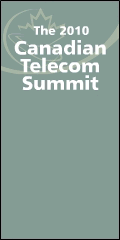Tuesday, February 02, 2010
Counting digital access
Yesterday, in attempting to clarify reporting rules for high speed digital access, the CRTC may have muddied the water a little more.
The problem is found in paragraph 22 from Telecom Regulatory Policy CRTC 2010-50?
But the CRTC's language is awkward and oxymoronic. After all, if fibre facilities are "dark", then they are not connecting a building at any speed, let alone greater than 45Mbps.
Further, competitive access carriers frequently don't provide DNA-type access; many deliver ethernet access services. As a result, the last sentence is not meaningful. Finally, the tone of the paragraph appears to seek information only for fibre connectivity, and it may also imply that only dedicated access services are relevant. These are inconsistent with principles of technical neutrality.
My suggestion for an erratum would use simpler language, such as:
The problem is found in paragraph 22 from Telecom Regulatory Policy CRTC 2010-50?
Parties to a high-speed DNA services forbearance application must provide the Commission with the addresses of all buildings that are connected to that carrier's network at speeds of DS-3 or greater irrespective of whether services at speeds of DS-3 or greater are currently being provided to that carrier's customer(s) located in that building and irrespective of whether the fibre facilities are lit (commissioned) or dark. Carriers are required to provide the addresses of the buildings that are so connected, not merely the addresses of the buildings where high-speed DNA services are currently being provided to customers.The intent, I think, is for competitive carriers to report a list of addresses of all buildings that are connected to their network with any kind of access facilities that could deliver higher than 45 Mbps. This report would be analyzed by the CRTC after an ILEC believes that there is a meaningful level of competition for high speed access services.
But the CRTC's language is awkward and oxymoronic. After all, if fibre facilities are "dark", then they are not connecting a building at any speed, let alone greater than 45Mbps.
Further, competitive access carriers frequently don't provide DNA-type access; many deliver ethernet access services. As a result, the last sentence is not meaningful. Finally, the tone of the paragraph appears to seek information only for fibre connectivity, and it may also imply that only dedicated access services are relevant. These are inconsistent with principles of technical neutrality.
My suggestion for an erratum would use simpler language, such as:
Parties to a high-speed DNA services forbearance application must provide the Commission with the addresses of all buildings that are connected to that carrier's network with facilities capable of access speeds greater than 45Mbps, irrespective of whether such access services are currently being provided in that building and irrespective of whether the facilities are commissioned or dark.
Comments:
<< Home
Generally address lists of on-net buildings are one of the best kept and carefully guarded secrets that a telco has. Do we have enough confidence that once carriers provide these lists, that the government can safeguard them?
Am I being overly paranoid?
:-)
Post a Comment
Am I being overly paranoid?
:-)
<< Home









